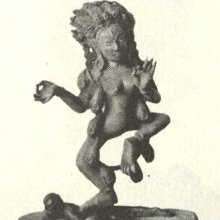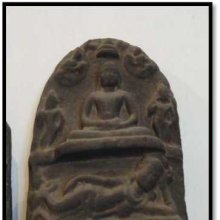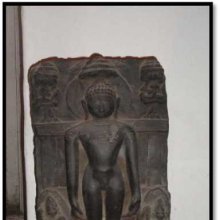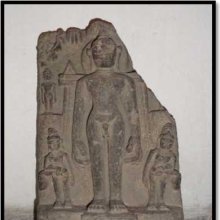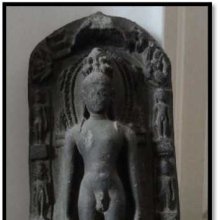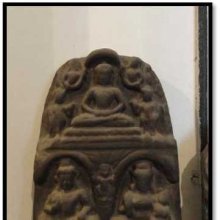Cauri, Caurī, Cāurī: 9 definitions
Introduction:
Cauri means something in Buddhism, Pali, Hinduism, Sanskrit, the history of ancient India, Marathi, Tamil. If you want to know the exact meaning, history, etymology or English translation of this term then check out the descriptions on this page. Add your comment or reference to a book if you want to contribute to this summary article.
Alternative spellings of this word include Chauri.
Images (photo gallery)
(+2 more images available)
In Buddhism
Tibetan Buddhism (Vajrayana or tantric Buddhism)
Source: archive.org: The Indian Buddhist IconographyCaurī (चौरी) refers one of the eight Gaurīs, commonly depicted in Buddhist Iconography, and mentioned in the 11th-century Niṣpannayogāvalī of Mahāpaṇḍita Abhayākara.—Her Colour is yellow; her Symbol is the noose; she has two arms.—The second goddess in the Gaurī group is Caurī.
Caurī is described in the Niṣpannayogāvalī (pañcaḍāka-maṇḍala) as follows:—
Source: academia.edu: The Structure and Meanings of the Heruka MaṇḍalaCaurī is yellow in colour and holds in her right hand the noose”.
[She shows the raised index finger in the left like all other deities of this group.
All the deities are violent in character with fearful appearance and ornaments, and garlands of heads. They dance in pratyālīḍha and show the raised index finger with clasped fist against the chest, as the common gesture.]
Caurī (चौरी) is also mentioned as the Ḍākinī of the northern gate in the Jñānacakra, according to the 10th century Ḍākārṇava chapter 15. Accordingly, the jñānacakra refers to one of the three divisions of the saṃbhoga-puṭa (‘enjoyment layer’), situated in the Herukamaṇḍala. The four gate Ḍākinīs [viz., Caurī] each has the same physical feature as the four Ḍākinīs starting with Lāmā.

Tibetan Buddhism includes schools such as Nyingma, Kadampa, Kagyu and Gelug. Their primary canon of literature is divided in two broad categories: The Kangyur, which consists of Buddha’s words, and the Tengyur, which includes commentaries from various sources. Esotericism and tantra techniques (vajrayāna) are collected indepently.
India history and geography
Source: Cologne Digital Sanskrit Dictionaries: Indian Epigraphical GlossaryCauri.—(ASLV), spelt chowrie in English; a flywhisk; some- times the right of its use was granted to persons as a mark of honour. See cāmara, cavarālu. Note: cauri is defined in the “Indian epigraphical glossary” as it can be found on ancient inscriptions commonly written in Sanskrit, Prakrit or Dravidian languages.

The history of India traces the identification of countries, villages, towns and other regions of India, as well as mythology, zoology, royal dynasties, rulers, tribes, local festivities and traditions and regional languages. Ancient India enjoyed religious freedom and encourages the path of Dharma, a concept common to Buddhism, Hinduism, and Jainism.
Languages of India and abroad
Marathi-English dictionary
Source: DDSA: The Aryabhusan school dictionary, Marathi-Englishcaurī (चौरी).—f A chowrie; see cavarī.
Marathi is an Indo-European language having over 70 million native speakers people in (predominantly) Maharashtra India. Marathi, like many other Indo-Aryan languages, evolved from early forms of Prakrit, which itself is a subset of Sanskrit, one of the most ancient languages of the world.
Sanskrit dictionary
Source: Cologne Digital Sanskrit Dictionaries: Monier-Williams Sanskrit-English Dictionary1) Caurī (चौरी):—[from caura] a f. a female thief. (heart-) captivator, [Kathāsaritsāgara vc, 54; civ, 168]
2) [v.s. ...] = ra-karman, [cf. Lexicographers, esp. such as amarasiṃha, halāyudha, hemacandra, etc.]
3) [from caura] b ind. (See ra) in [compound]
4) [v.s. ...] f. (See ra) in [compound]
Source: DDSA: Paia-sadda-mahannavo; a comprehensive Prakrit Hindi dictionary (S)Caurī (चौरी) in the Sanskrit language is related to the Prakrit word: Corī.
[Sanskrit to German]
Sanskrit, also spelled संस्कृतम् (saṃskṛtam), is an ancient language of India commonly seen as the grandmother of the Indo-European language family (even English!). Closely allied with Prakrit and Pali, Sanskrit is more exhaustive in both grammar and terms and has the most extensive collection of literature in the world, greatly surpassing its sister-languages Greek and Latin.
Kannada-English dictionary
Source: Alar: Kannada-English corpusCauri (ಚೌರಿ):—
1) [noun] the long hair of yak (Bos gruniens).
2) [noun] a fan made of this.
3) [noun] a bunch of long hair tightly tied at one end and let loose at the other, interwoven with the hair of women while braiding.
4) [noun] a kind of ornament for the head used by women.
5) [noun] an erstwhile coin used during the reign of the provincial rulers of Citradurga, in Karnāṭaka.
6) [noun] an ornamental tuft used to decorate pandals, podia, platforms, etc.
Kannada is a Dravidian language (as opposed to the Indo-European language family) mainly spoken in the southwestern region of India.
See also (Relevant definitions)
Starts with (+7): Cauria, Cauribhuta, Caurige, Caurika, Caurikaka, Caurikaya, Caurikottu, Caurikuppige, Caurikya, Caurima, Caurimdiya, Caurimdriya, Caurimise, Caurinu, Caurisurata, Caurisuratapancashika, Cauriya, Cauriyahattara, Cauriyam, Cauriyan.
Ends with: Akkanacauri, Gomdecauri, Kacauri, Kallanacauri.
Full-text (+2): Caurikaka, Cauribhuta, Vibukosha, Caurisurata, Cori, Caurika, Udvahana, Caumri, Cirikaka, Cauli, Caurapancashika, Cavaralu, Camara, Caturdevi, Dhvajabaddhaka, Konavasi, Trimurti, Trinabindu, Vishuddhaheruka, Krodhishvari.
Relevant text
Search found 9 books and stories containing Cauri, Caurī, Cāurī; (plurals include: Cauris, Caurīs, Cāurīs). You can also click to the full overview containing English textual excerpts. Below are direct links for the most relevant articles:
Jain Remains of Ancient Bengal (by Shubha Majumder)
Single depiction of Mahāvīra sculptures < [Chapter 6 - Iconographic Study of Jaina Sculptural Remains]
Pañca-tīrthika type of Mahāvīra sculptures < [Chapter 6 - Iconographic Study of Jaina Sculptural Remains]
Tīrthaṅkara Pārśvanātha with Planetary deities and Dikpālas type < [Chapter 6 - Iconographic Study of Jaina Sculptural Remains]
Maha Prajnaparamita Sastra (by Gelongma Karma Migme Chödrön)
1. Debate with the Realist < [Part 12 - Non-existence of the outer object]
Guhyagarbha Tantra (with Commentary) (by Gyurme Dorje)
Text 16.3 (Commentary) < [Chapter 16 (Text and Commentary)]
Text 15.25 (Commentary) < [Chapter 15 (Text and Commentary)]
Chapter 16 - Emanation of the Maṇḍala of Buddha-speech < [Chapter 16 (Text and Commentary)]
Matangalila and Hastyayurveda (study) (by Chandrima Das)
The Devi Bhagavata Purana (by Swami Vijñanananda)
Amarakoshodghatana of Kshirasvamin (study) (by A. Yamuna Devi)
Related products
